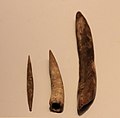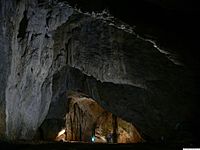Aurignacian
  Lion drawings from the Chauvet Cave, 37,000 to 33,500 years old, and a map of Aurignacian sites. | |
| Geographical range | Eurasia |
|---|---|
| Period | Upper Paleolithic |
| Dates | c. 43,000 – c. 28,000 BP[1][2] |
| Type site | Aurignac |
| Preceded by | Ahmarian, Châtelperronian |
| Followed by | Gravettian, Mal'ta–Buret' culture |
| Defined by | Breuil and Cartailhac, 1906[3] |
The Aurignacian (
The Proto-Aurignacian and the Early Aurignacian stages are dated between about 43,000 and 37,000 years ago. The Aurignacian proper lasted from about 37,000 to 33,000 years ago. A Late Aurignacian phase transitional with the Gravettian dates to about 33,000 to 26,000 years ago.[6][5] The
One of the oldest examples of
A "Levantine Aurignacian" culture is known from the Levant, with a type of blade technology very similar to the European Aurignacian, following chronologically the Emiran and Early Ahmarian in the same area of the Near East, and also closely related to them.[7] The Levantine Aurignacian may have preceded European Aurignacian, but there is a possibility that the Levantine Aurignacian was rather the result of reverse influence from the European Aurignacian: this remains unsettled.[8]
Main characteristics
The Aurignacians are part of the wave of
The Aurignacian tool industry is characterized by worked
Art
Aurignacian figurines have been found depicting faunal representations of the time period associated with now-extinct
Many 35,000-year-old animal figurines were discovered in the Vogelherd Cave in Germany.[11] One of the horses, amongst six tiny mammoth and horse ivory figures found previously at Vogelherd, was sculpted as skillfully as any piece found throughout the Upper Paleolithic. The production of ivory beads for body ornamentation was also important during the Aurignacian. The famous paintings in Chauvet cave date from this period.
Typical statuettes consist of women that are called
Aurignacian finds include bone
Gallery
-
Decorated ivory pendant from Stajnia Cave, Poland, c. 41,500 BP[16]
-
Bone flute, 35,000-40,000 years old
-
The Adorant of Geissenklösterle, Germany
-
The Adorant of Geissenklösterle, reverse side with notches
-
The Venus of Hohle Fels figurine (height 6cm), 35,000 BP
-
Horse figurine from Vogelherd Cave, Germany
-
Animal figurine from Vogelherd Cave
-
Chauvet Cave painting, France
-
Possible musical bow from Geisenklösterle, Germany
-
Lion head sculpture, Vogelherd cave
-
Lion sculpture, Vogelherd cave
-
Mammoth sculpture, Vogelherd cave
-
Venus of Galgenberg, Austria
-
Carved ivory from Brillenhöhle cave
-
Engraved plaque from Abri Lartet, France
-
Engraved plaque from Abri Blanchard, France
-
Aurignacian jewellery, Belgium
-
A painting of a hand in the Cave of Aurignac, France
-
Jewelry, Fazael, Israel, Upper Paleolithic.
-
A carving of a running horse,Hayonim Cave, Levant.
Tools
-
A bone point
-
Aurignacian blades
-
Dufour bladelet
-
Bone tools,Hayonim Cave, 30000 BP.
-
Aurignacianmicroliths
Population
A 2019 demographic analysis estimated a mean population of 1,500 persons (upper limit: 3,300; lower limit: 800) for western and central Europe during the Aurignacian period (~42,000 to 33,000 y cal BP).[21]
A 2005 study estimated the population of Upper Palaeolithic Europe from 40–30 thousand years ago was 1,738–28,359 (average 4,424).[22]
Association with modern humans
The sophistication and self-awareness demonstrated in the work led archaeologists to consider the makers of Aurignacian
At least three robust, but typically anatomically-modern, individuals from the
Genetics

In a genetic study published in
The Aurignacian material culture is associated with the expansion of 'early West Eurasians' during the Upper-Paleolithic, replacing or merging with previous Initial Upper Paleolithic cultures to which possibly relates the European Châtelperronian.[29][30]

Location
Europe
Near-East
- Ksar Akil
- Hayonim Cave
Asia
Lebanon/Palestine/Israel region
- Contained within a stratigraphic column, along with other cultures.[31]
- Many sites in Siberia including around
-
Entrance porch of the Cave of Aurignac
-
Hayonim Cave
-
Interior of Bacho Kiro cave
See also
| The Paleolithic |
|---|
| ↑ Pliocene (before Homo) |
| ↓ Mesolithic |
- Cave of Aurignac
- Ksar Akil
- Venus figurines
- Bacho Kiro cave
Notes
- Kostenki-14 (Russia): C1b, Goyet Q116-1 (Belgium) C1a,[25] Sungir (Russia): C1a2, Ust'-Ishim and Oase-1: K2a[26]
- ^ Haplogroup N was found in two Gravettian-era fossils, Paglicci 52 Paglicci 12, and is widespread in Central Asia[28]
References
- ISBN 9781461507512.
- ISBN 9781139619387.
- JSTOR 27906750.(subscription required)
- ^ ISBN 9780226027524.
- ^ ISBN 9781444342475.
- PMID 19571003.. Jacobi, R.M.; Higham, T.F.G.; Haesaerts, P.; Jadin, I.; Basell, L.S. (2010). "Radiocarbon chronology for the Early Gravettian of northern Europe: new AMS determinations for Maisières-Canal, Belgium". Antiquity. 84 (323): 26–40.S2CID 163089681.
- ISBN 9781107006980.
- ^ Williams, John K. (2006). "The Levantine Aurignacian: a closer look" (PDF). Lisbon: Instituto Português de Arqueologia (Trabalhos de Arqueologia Bar-Yosef O, Zilhão J, Editors. Towards a Definition of the Aurignacian. 45): 317–352.
- ^ Fu 2016: "GoyetQ116-1 is chronologically associated with the Aurignacian cultural complex. Thus, the subsequent spread of the Vestonice Cluster, which is associated with the Gravettian cultural complex, shows that the spread of the latter culture was mediated at least in part by population movements."
- ^ S2CID 85316570.
- ^ Finds from the Vogelherd cave Archived 2007-09-30 at the Wayback Machine
- S2CID 205216692.
- ^ Henderson, Mark (2009-05-14). "Prehistoric female figure 'earliest piece of erotic art uncovered'". The Times. London.
- ^ S2CID 4336590.
- ^ Richard Leakey & Roger Lewin, Origins Reconsidered: In Search of What Makes Us Human (1992)
- S2CID 244699451.
Here, we report the discovery of the oldest known human-modified punctate ornament, a decorated ivory pendant from the Paleolithic layers at Stajnia Cave in Poland. ... The punctate decorative motif is one of the artistic innovations that developed during the Early Aurignacian in Europe and the Eurasian Upper Paleolithic in the Russian Plains. Thus far, these marks on mobile objects have been interpreted as hunting tallies, arithmetic counting systems, or lunar notation, whereas others have suggested aesthetic purposes. The looping curve represented on the Stajnia pendant is similar to the engraved patterns of the Blanchard plaque. Whether these marks indicate cyclic notations or kill scores remain an open question, although the resemblance with the lunar analemma is striking.
- S2CID 164106990.
- S2CID 206632421.
The few AMH fossils associated with these initial UP industries are morphologically variable. In western Eurasia, the distinctive Aurignacian toolkit, first observed at Willendorf (Austria) by 43.5 ka, became predominant across the earlier range by 39 ka. Although analyses of ancient human genomes have advanced our understanding of the European past, revealing contributions from Paleolithic Siberians, European Mesolithic, and Near Eastern Neolithic groups to the European gene pool, the possible contribution of the earliest Eurasians to these later cultures and to contemporary human populations remains unknown. To investigate this, we sequenced the genome of Kostenki 14 (K14, Markina Gora)
- S2CID 32216495.
The determination of a complete genome from ancient mtDNA extracted from a skeleton associated with Layer III at Kostenki 14 indicates that mtDNA subgroup U2 is represented among the people who occupied the central East European Plain at ca. 35,000 cal BP. This subgroup is widely distributed today in southern and central Asia, the Near East, and Europe, and is linked to one of the oldest genetic markers in Europe, mtDNA haplogroup U. At Kostenki 14, this subgroup is associated with artifacts assigned to the Gorodtsovan Culture but reinterpreted here as an Eastern Aurignacian assemblage.
- S2CID 157720076.
The newly obtained dates make it possible to state that the burial in Markina Gora, according to calibrated data, is dated to within 38700-36200 years ago [8]. By the European scale, these dates synchronized it with the earliest Aurignacian complexes, among which the burial under study has a unique preservation
- PMID 30759115.
Demographic estimates are presented for the Aurignacian techno-complex (~42,000 to 33,000 y calBP) and discussed in the context of socio-spatial organization of hunter-gatherer populations. Results of the analytical approach applied estimate a mean of 1,500 persons (upper limit: 3,300; lower limit: 800) for western and central Europe.
- .
- S2CID 34614953., "Sequencing of 81 entire human mitochondrial DNAs (mtDNAs) belonging to haplogroups M1 and U6 reveals that these predominantly North African clades arose in southwestern Asia and moved together to Africa about 40,000 to 45,000 years ago. Their arrival temporally overlaps with the event(s) that led to the peopling of Europe by modern humans and was most likely the result of the same change in climate conditions that allowed humans to enter the Levant, opening the way to the colonization of both Europe and North Africa. Thus, the early Upper Palaeolithic population(s) carrying M1 and U6 did not return to Africa along the southern coastal route of the "out of Africa" exit, but from the Mediterranean area; and the North African Dabban and European Aurignacian industries derived from a common Levantine source."
- ^ Fu 2016.
- PMID 27135931.
- PMID 28982795.
- S2CID 206632421.
- PMID 12743370.
- PMID 35445261.
The UP branch would have then emerged from a putative OoA population Hub well after 45 ka, a scenario that finds support in previous hypotheses on the appearance of UP techno-complexes (e.g. Aurignacian) in Europe, although the role of migrations and exchange between Europe, Western Asia, and the Levant is still debated (Conard 2002; Mellars 2006; Teyssandier 2006; Davies 2007; Hoffecker 2009; Le Brun-Ricalens et al. 2009; Nigst et al. 2014; Zilhão 2014; Hublin 2015; Bataille et al. 2020; Falcucci et al. 2020).
- ISSN 2520-8217.
- ^ ISBN 978-0-395-13592-1.
- ^ Debeljak, Irena; Turk, Matija. "Potočka zijalka". In Šmid Hribar, Mateja; Torkar, Gregor; Golež, Mateja; et al. (eds.). Enciklopedija naravne in kulturne dediščine na Slovenskem – DEDI (in Slovenian). Archived from the original on 2012-05-15. Retrieved 12 March 2012.
Sources
- Fu, Qiaomei (May 2, 2016). "The genetic history of Ice Age Europe". PMID 27135931.
External links
- Picture Gallery of the Paleolithic (reconstructional palaeoethnology), Libor Balák at the Czech Academy of Sciences, the Institute of Archaeology in Brno, The Center for Paleolithic and Paleoethnological Research

![Decorated ivory pendant from Stajnia Cave, Poland, c. 41,500 BP[16]](http://upload.wikimedia.org/wikipedia/commons/thumb/9/94/A_41%2C500_year-old_decorated_ivory_pendant_from_Stajnia_Cave_%28Poland%29_1.png/120px-A_41%2C500_year-old_decorated_ivory_pendant_from_Stajnia_Cave_%28Poland%29_1.png)






















![The entrance to the Potočka Zijalka, a cave in the Eastern Karavanke, where the remains of a human residence dated to the Aurignacian (40,000 to 30,000 BP) were found.[32]](http://upload.wikimedia.org/wikipedia/commons/thumb/3/39/Potok_Cave_-_Poto%C4%8Dka_zijalka_%28Slovenia%29.JPG/150px-Potok_Cave_-_Poto%C4%8Dka_zijalka_%28Slovenia%29.JPG)


